Antisemitism and the Brick Lane mural: A retrospective assessment
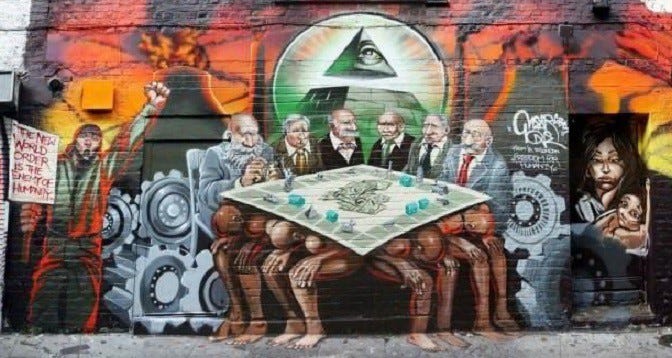
It’s ten years since the creation, and rapid obliteration, of a now infamous mural off Brick Lane in East London. Titled “Freedom For Humanity — False Profits”, it was the work of US artist Kalen Ockerman, aka Mear One, and immediately provoked complaints about the alleged use of antisemitic imagery. Although the identity of the six figures seated at a Monopoly board resting on the backs of the oppressed masses was then unknown, the complainants’ assumption was that the individuals depicted were Jewish financiers.
The mayor of Tower Hamlets, Lutfur Rahman, reacted to these complaints by ordering the mural to be painted over. “Whether intentional or otherwise”, he stated, “the images of the bankers perpetuate antisemitic propaganda about conspiratorial Jewish domination of financial and political institutions.” Others questioned that decision. As everyone now knows, in response to a Facebook post in which Ockerman indignantly protested against the erasure of his work, Jeremy Corbyn asked: “Why? You are in good company. Rockerfeller destroyed Diego Viera’s mural because it includes a picture of Lenin.”
Bear in mind that at this point the mural controversy hadn’t even received local press coverage. It wasn’t until the day after Corbyn posted his comment that the East London Advertiser reported on the objections to the mural and the decision to remove it. Mear One’s Facebook post, on which Corbyn was commenting, itself made no mention of the reason for the artwork being suppressed. So it’s reasonable to conclude that Corbyn was entirely unaware of the accusations of antisemitism. His reference to Mexican artist Diego Rivera’s 1933 fresco Man at the Crossroads indicates that he thought it was the anti-capitalist character of the mural that was the likely cause of its removal.
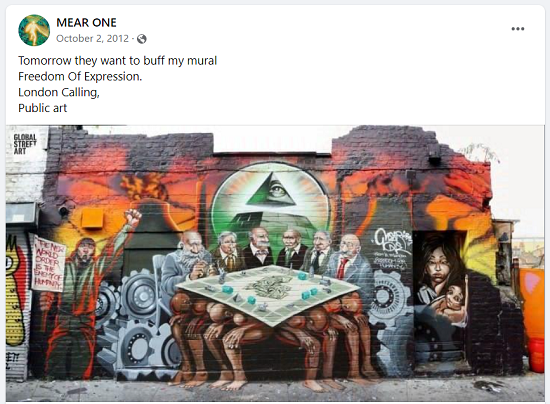
At the time the controversy attracted limited attention outside of the East London and Jewish community press, and barely registered in the national media, while Corbyn’s comment was ignored completely. Three years later, shortly after his election as Labour leader, the Jewish Chronicle did make an attempt to generate interest in the story — referring cautiously to Corbyn having “apparently backed” a mural with alleged “antisemitic undertones” — but it failed to gain traction. In 2016 the Sunday Telegraph had another go at creating a scandal over the issue, but similarly met with no success.
In March 2018, however, long after it had been forgotten, the controversy was suddenly reignited by then Labour MP Luciana Berger, as part of the campaign by the Labour right and their allies in the Zionist establishment to undermine Jeremy Corbyn. This time it produced a quite hysterical reaction, with the Board of Deputies and the Jewish Leadership Council organising an angry demonstration outside parliament to denounce the Corbyn-led Labour Party as a hotbed of antisemitism.
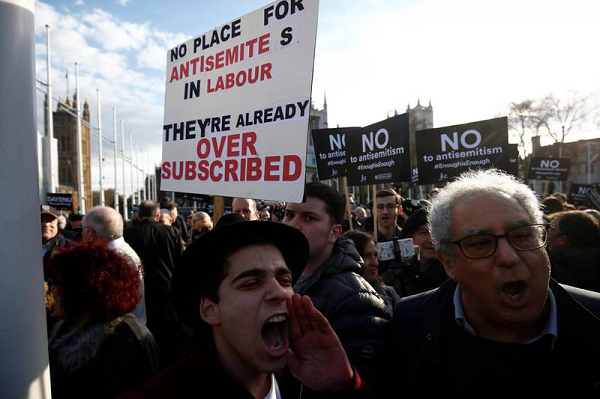
Back in 2012, even David Toube of Harry’s Place had been initially inclined to give Ockerman the benefit of the doubt over the mural, observing that he had “seen more obvious stereotypes of Jews deployed in antisemitic art”. In 2018, by contrast, Corbyn’s critics declared the mural to be self-evidently and unambiguously antisemitic, and denounced his failure to have immediately recognised this as proof that he was oblivious to antisemitism, if not an outright antisemite himself.
David Baddiel, writing in the Sunday Times, claimed to identify a clear parallel between the caricatures in the mural and “the depictions of hook-nosed Jewish bankers holding the world to ransom that were published weekly in the Nazi newspaper Der Stürmer”. Indeed, according to Baddiel, the mural might easily have served as “a cover of a reprint of The Protocols of the Elders of Zion, the anti-semitic text from 1903 that purports to show a Jewish plot for world domination”. How, he wanted to know, could Corbyn possibly have failed to spot such a blatant expression of antisemitism?
In his recent book Whatever Happened to Antisemitism? Tony Lerman points out that Baddiel’s claims were simply inaccurate. “The typical ‘Jew’ in Der Stürmer”, he writes, “has an exaggerated hook nose, a bulging, protruding fleshy lower lip, an unshaven rather than always bearded face, eyes suggesting rapacious intent. The figures in the mural, irrespective of what Ockerman has said about them, look like cuddly teddy bears in comparison.” An internet search for editions of The Protocols “reveals nothing resembling the mural. Covers are either text, usually designed to indicate the ‘seriousness’ of the publication, or gross caricatures of Jews barely showing any resemblance to the men sitting around the Monopoly board.”
There is a good reason why the figures in the mural don’t look much like far-right caricatures of Jews — namely that most of them aren’t actually Jewish. In his reply to the renewed attack on his artwork in 2018 Ockerman helpfully identified the six individuals he had portrayed. It turned out that only two of them were Jewish bankers (a Rothschild — almost certainly Walter, of Balfour Declaration fame — and Paul Warburg). Three others were non-Jewish capitalists (John D. Rockefeller, J.P. Morgan and Andrew Carnegie) while the sixth figure was the occultist Aleister Crowley. There is really only one of these figures that bears any similarity to a classic antisemitic caricature, and that’s the individual on the left counting money, who is apparently Walter Rothschild.
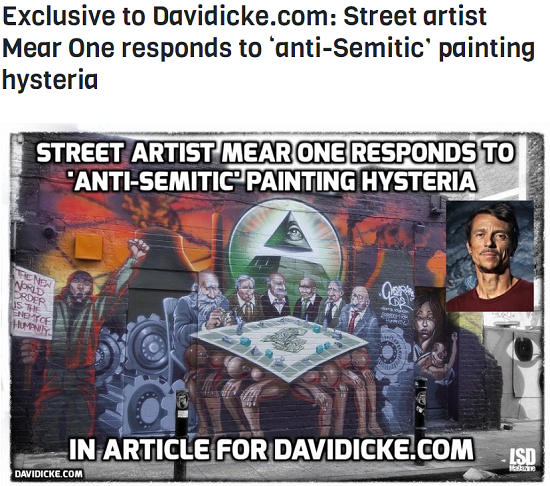
The obvious question, which few bothered to ask, was — how did Ockerman come to pick this rather bizarre cast of characters to represent capitalist oppression? It was Ockerman’s choice of the website of crank conspiracy theorist David Icke as a platform to defend his artwork, and his acknowledgement of Icke as an important source of inspiration, that provided a pointer to the thinking behind the mural’s composition. A quick search through texts readily available online revealed that the individuals Ockerman had selected — Rothschild, Warburg, Rockefeller, Morgan, Carnegie and Crowley — all feature prominently in Icke’s writings. In fact the mural would appear to be based in large part on Icke’s deluded antisemitic fantasy that the world is under the control of “Rothschild Zionism”.
In 2016 Ockerman tweeted his support for an Icke video on that subject, urging his followers to “give one of my heroes a listen”, and in a Facebook post promoting the same video he specifically related it to the earlier controversy over the mural. Acclaiming Icke as “one of a select few who are willing to take a stand against the crimes of humanity committed by the Zionist elite governing the state of Israel and the U.S.”, Ockerman accused this elite of “making huge profit on the demise and disenfranchisement of hard working people”. He ended his post with the hashtag #FreedomForHumanity, which of course was the title of the mural.
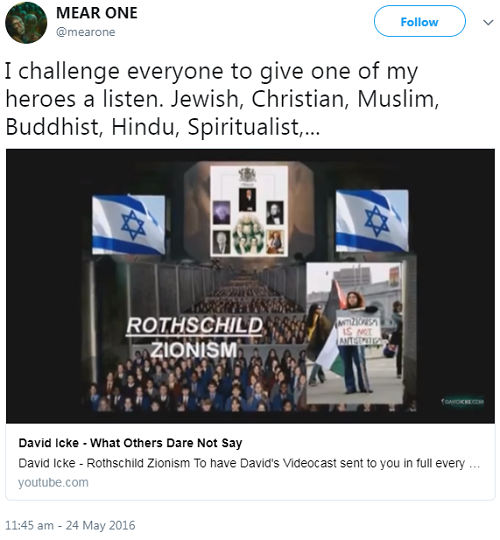
According to Icke the “Rothschild Zionists” consist of the Rothschilds themselves plus the numerous businessmen and politicians who have served as their accomplices. Some of these individuals are fellow Jews. Paul Warburg, for example, is described in The David Icke Guide to the Global Conspiracy (and how to end it) as a “Rothschild agent” who was sent to the US “to create the privately-owned (Rothschild-controlled) ‘American’ central bank called the Federal Reserve”. But others are not Jewish. Icke repeatedly refers to the Rockefellers, Morgan and Carnegie as examples of gentile capitalists who have acted as Rothschild front men, behind whom these evil Jewish bankers secretly exercise their power. In his book Human Race Get Off Your Knees he writes:
“The Rothschilds have a horrific record of engineering wars, including the world wars, instigating financial crashes and manipulating countries across every continent via the networks they control. There is not a single man, woman or child whose life is not affected, often disastrously, by the Rothschilds. Their power and influence was once well known, and politicians cowered before them in the knowledge that without their sanction they would either never experience high political office, or stay there for long if they did.
“Their control and manipulation became so obvious that their plans were in danger of exposure, and since the early years of the 20th century they have brilliantly disguised the extent of their ownership and power structure by using nominee directors and other front people, including the Rockefeller family and ‘independent’ industrialists and tycoons like J P Morgan, Andrew Carnegie, Edward R Harriman and a stream of others. When you see those names you are looking at another word for Rothschild.”
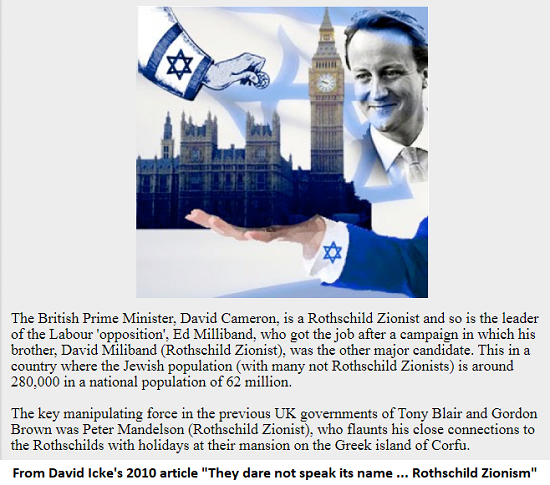
So five of the six figures depicted by Ockerman — Rothschild, Warburg. Rockefeller, Morgan and Carnegie — are part of Icke’s “Rothschild Zionist” conspiracy. The exception is Aleister Crowley. He too appears in Icke’s writings, as a “Satanist, Freemason and Illuminati operative” who supposedly channelled a malevolent fourth dimensional force called the “Prison Warders” and acted as adviser to both Churchill and Hitler. Deranged though this may be, there’s nothing antisemitic about it. But Ockerman himself has included Crowley in another conspiracy theory, possibly of his own devising, according to which Crowley’s disciples were responsible for the Manhattan Project and also Operation Paperclip, which it comes as no surprise to hear was “secretly funded by the Illuminati banking cartel headed by the Rothschild Family”.
Also worth noting is the revised print version of the mural that Ockerman produced in 2016, where his Icke-derived view of the dominant role of the Rothschilds was made even clearer. Of the ten individuals depicted in that work, representing the capitalist/Illuminati rulers of the world, four were members of the Rothschild family. A fifth was George Soros, who for antisemites these days ranks alongside the Rothschilds themselves as a symbol of the controlling power of international Jewish financiers.
In his self-justificatory article on Icke’s website Ockerman provided further insights into the ideology underpinning his artwork, explaining his use of the Eye of Providence symbol in the mural on the grounds that it was an example of “sacred Freemason iconography” taken from the US dollar bill. He also noted that the dollar’s design included “several other hidden symbols, which some may argue have Jewish influences, such as the star configuration that rises above the eagle crest forming a two-dimensional tetrahedron, considered by some as the star of David, I always wondered why?” This association of Jews and Freemasons, particularly in the context of Ockerman’s belief that they are part of a plan to impose a “New World Order”, carried disturbing echoes of the Judeo-Masonic conspiracy theory that originated in The Protocols.
In short the mural undoubtedly was antisemitic, but you couldn’t tell that just by looking at it — which is why the denunciations of Corbyn were so misplaced and unjust. To understand the antisemitic character of the work you had to delve into the conspiracist ideology that inspired it. The problem is that most people commenting on the controversy over the years haven’t bothered to do that. On the one hand you have people like David Baddiel dogmatically asserting that the mural is manifestly antisemitic because it’s supposedly filled with egregiously anti-Jewish caricatures. On the other hand you have some people on the left equally dogmatically insisting that the mural can’t possibly be antisemitic because most of the individuals caricatured in it are not Jewish. As I hope this article has demonstrated, they’re both wrong.
First published on Medium in October 2022